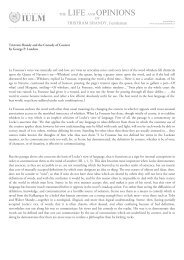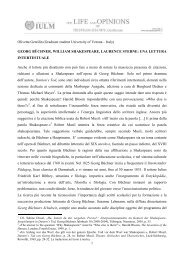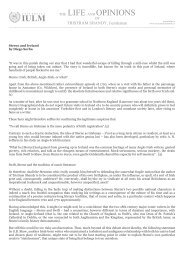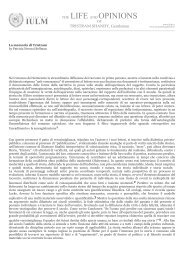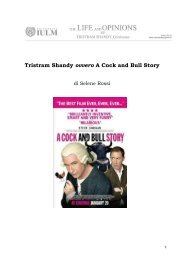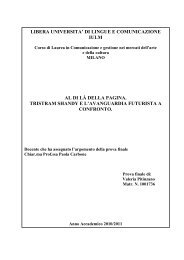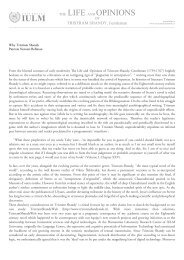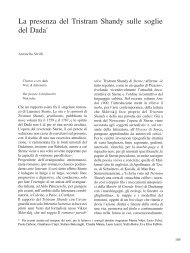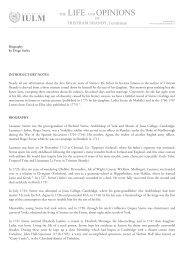Wedding In 18th Century By DiGiove - The Tristram Shandy Web
Wedding In 18th Century By DiGiove - The Tristram Shandy Web
Wedding In 18th Century By DiGiove - The Tristram Shandy Web
You also want an ePaper? Increase the reach of your titles
YUMPU automatically turns print PDFs into web optimized ePapers that Google loves.
<strong>Wedding</strong> in <strong>18th</strong> <strong>Century</strong><br />
by Livia di Giovine<br />
<strong>Tristram</strong> <strong>Shandy</strong> is an extremely complex novel. Its own fictitious narrator describes it as a machine (Book I, chap.XXII), in<br />
which everything is carefully planned. Nothing is left to chance; even the chaotic, fragmentary and apparently aimless plot<br />
hides an ambitious project which aims at representing the spontaneousness of thoughts floating in the human mind. As a<br />
consequence, every element, even the most banal and absurd, has to be considered an essential part of this mechanism.<br />
I focused my attention on the wedding settlement which is quoted in the first book of <strong>Tristram</strong> <strong>Shandy</strong>, in order to analyse<br />
what kind of role it is supposed to play within the novel: is it just a technical device through which the author tries to enrich<br />
his prolix and confused plot or is it something more? <strong>By</strong> raising the legal document to an entirely new point of view I will<br />
show the relationship which strongly links the settlement to themes such as the novel's structure, its language theories and its<br />
realism. From literary aspects of the novel which the critics have widely investigated to references to the eighteenth-century<br />
historical background, I will try to offer a different reading approach to Sterne's masterpiece.<br />
THE WEDDING SETTLEMENT AND REALISM<br />
www.iulm.it<br />
www.tristramshandyweb.it<br />
<strong>In</strong> �e Rise of the Novel, Ian Watt maintains that Sterne's <strong>Tristram</strong> <strong>Shandy</strong> can be considered to be a realistic novel; he<br />
recognizes Sterne's ability to portray scenes which 'achieve a living authenticity' (p.331). Like his predecessors (Defoe,<br />
Richardson) Sterne employed technical devices which allowed him to create an original and convincing work. �e wedding<br />
settlement can be conceived as a useful means through which the author succeeded in this literary task.<br />
As far as the content is concerned a realist writer draws his inspiration from daily life. �e audience was gradually widening<br />
and this new condition required stories and anecdotes in which people could identify themselves easily. �e wedding<br />
settlement thus witnesses Sterne's attempt to provide his plot with true life, with characters whose actions corresponded to real<br />
behaviour and habits. <strong>By</strong> this device the author referred indirectly to a legal act which had been published in that period. �e<br />
'Marriage Act' (1753) consisted of a series of rules which gave the wedding practice an order; anarchy was finally replaced by<br />
law (see �e wedding settlement and the historical background). Moreover, his personal experience as a parson caused Sterne<br />
to face directly the consequences and echoes of such an act on society. �is way history, together with a deep knowledge of<br />
virtues and vices of English upper-middle class, became the source of a novel based on some veiled considerations upon the<br />
role of wedding and the role of family in a society which was wholly built on both these principles.<br />
But how did Sterne represent this realistic content? <strong>In</strong> order to describe his contemporary world the author turned to a<br />
microcosm: <strong>Shandy</strong>-Hall symbolizes English society. <strong>By</strong> representing the family members' behaviour and actions, Sterne<br />
mirrored habits and customs which were typical features of the class he wanted to portray. As a consequence characters are<br />
supposed to be credible. Biography or epistolary novel were the most common narrative forms because they allowed the writer<br />
to hide himself behind a narrator who tells the reader everything about his life. As for <strong>Tristram</strong> <strong>Shandy</strong>, the homonymous<br />
character, addressed the reader introducing himself, his family and his opinions. To be precise, <strong>Tristram</strong> gives a peculiar<br />
account of his life by following the thoughts floating in his mind. �is way the reader can learn how the narrator's mind<br />
moves, and what he really thinks. Nothing seems to be left unknown to the reader and he is not suspicious: he believes he<br />
knows everything, and he believes everything.
As the narration does not follow the traditional chronological order but the one of the protagonist's mind, the reader happens<br />
to read anecdotes which are often disconnected. Such a peculiar sequence can lead the reader to confusion, thus undermining<br />
the plot's credibility. But the constant presence of the wedding settlement within the narration helps restore the reader's<br />
confidence in what he/she is reading. <strong>The</strong> document indeed proves to be a sort of glue: being the starting point of the whole<br />
plot, it becomes the reference point to which the various anecdotes are often directly or even indirectly linked. <strong>The</strong>refore, the<br />
reader manages to orientate himself within the chaos of <strong>Tristram</strong>'s mind and of the narration (see <strong>The</strong> wedding settlement and<br />
the unity of the text).<br />
<strong>The</strong> novel's authenticity is also preserved by details and by using extra-textual elements: once again the marriage contract<br />
allows Sterne to confer more truth to characters and situations. <strong>Tristram</strong> faithfully quotes the 'original' document which deals<br />
with his parents' wedding. Those few pages certify the existence of Elizabeth and Walter <strong>Shandy</strong>, the union between the two<br />
before the law. Moreover, by presenting the document the writer also certifies that the whole plot is real: <strong>Tristram</strong>'s life and<br />
opinions all derive from this settlement. Sterne was able to obtain such realistic nuances through a marvellous reproduction of<br />
the document. <strong>The</strong> author managed to create the same peculiar structure and vocabulary which characterize juridical<br />
documents (see <strong>The</strong> wedding settlement and Sterne's language theories). Sterne's great skill was his attention in matching each<br />
situation to its language.<br />
<strong>In</strong> the end, by paraphrasing Watt, <strong>Tristram</strong> <strong>Shandy</strong> demonstrates to be a realistic novel whose realism is mainly due to Sterne's<br />
ability to present reality.<br />
THE WEDDING SETTLEMENT AND ITS HISTORICAL BACKGROUND<br />
Being a parson Sterne was a public figure who was necessarily involved in social debate. When Sterne began to write his novel,<br />
England was living important social changes: the Lord Hardwicke Marriage Act was issued in 1753, and the echoes and<br />
consequences of these new rules were slowly developing in society. <strong>Tristram</strong> <strong>Shandy</strong> reflects some aspects of this feature: the<br />
presence of the wedding settlement and a plot which basically deals with marital and family relationships aim to represent<br />
ironically virtues and vices of some English habits. Irony, therefore, helps to emphasise those aspects of life which were<br />
ridiculous and unfair in the author's view.<br />
When Mr. and Mrs. <strong>Shandy</strong> got married, they fixed the usual legal arrangement. According to the contract, Mrs. <strong>Shandy</strong> was<br />
granted the freedom and right to give birth where she most liked and to be assisted by the midwife she preferred even after<br />
they had already moved from London to <strong>Shandy</strong> Hall. <strong>The</strong> agreement seemed to be particularly equal at first. Unluckily Mr.<br />
<strong>Shandy</strong>'s fear of unfair play on the part of his wife led him to add a further clause to the document: his generous concessions<br />
were to be valid just for once. This clause was held responsible for all the misfortunes which occurred to poor <strong>Tristram</strong>: having<br />
moved to London because of a hysterical pregnancy in 1717, Mrs. <strong>Shandy</strong> wasted her right to claim the wedding contract.<br />
<strong>The</strong>refore, later, when she was about to give birth to <strong>Tristram</strong>, Mr. <strong>Shandy</strong> forced his wife to stay at <strong>Shandy</strong> Hall as the said<br />
clause mentioned established. <strong>The</strong> woman did not even dare to complain, but adapted herself to the absurd situation.<br />
Mr. <strong>Shandy</strong>'s prejudice against his wife's loyalty could lead the reader to picture Mrs. <strong>Shandy</strong> as a devil whose first goal was to<br />
make fun of her husband. But if we go on reading, we realise that the real victim is Elizabeth, while Mr. <strong>Shandy</strong> is the one<br />
who plays unfairly. She proved to be weaker than women like Aunt Dinah or Walter's grandmother, who succeeded in<br />
obtaining what they really wanted. Aunt Dinah refused traditional social habits in order to marry the man she loved, although<br />
he belonged to a lower class. Walter's grandmother forced her husband to increase the life estate which she was supposed to<br />
receive if she outlived her husband. Mrs. <strong>Shandy</strong> distinguished herself in her passivity: she was not particularly cultivated, and<br />
was not at all interested in her husband's studies and intellectual hobbies (Book II, chap.XIX); her attitude usually annoyed<br />
Mr. <strong>Shandy</strong>. She barely intervened in family affairs: when their beds of justice (Book VI, chap.XVIII) took place, she hardly<br />
spoke. She kept repeating her husband's words without expressing any of her opinions. Moreover, although she had had<br />
something to say, Mr. <strong>Shandy</strong> would have never let her speak because of his quite selfish temperament. This way her loquacity<br />
was due not so much to her poor cultural background, but to her being a woman; it was a male opinion that female natural<br />
inferiority excluded women from any kind of decision. With reference to this social belief, Sterne wrote an amusing and ironic<br />
episode: when Mr.<strong>Shandy</strong> allowed his wife to choose the midwife she preferred, Dr.Slop complained about the freedom the<br />
man had given Mrs.<strong>Shandy</strong> (Book II, chap.XVIII). According to the doctor that was not a matter in which a woman could
interfere; in other words she was not allowed to decide how to live her pregnancy.<br />
This lack of communication within husband and wife was further worsened by a total lack of feelings and passion. Even<br />
intimacy was turned into a sterile appointment: intercourse was scheduled monthly after Mr. <strong>Shandy</strong> had wound up the<br />
house-clock. <strong>The</strong> couple's gestures were totally mechanical; there was not any natural involvement as the scene of <strong>Tristram</strong>'s<br />
conception reveals (Book I, chap.I). Marital life indeed seemed to be characterized mostly by coldness rather than complicity.<br />
Family life also seemed to reflect such indifference and lack of feeling: according to contemporary habits both Mr. and Mrs.<br />
<strong>Shandy</strong> left <strong>Tristram</strong> on his own, abandoned to a nanny. When Walter <strong>Shandy</strong> realized that his son had lived too many<br />
misfortunes (<strong>Tristram</strong>'s conception, birth and baptism were a total failure; nothing went as Mr.<strong>Shandy</strong> had planned) he<br />
decided to write a pedagogical essay about how he was going to bring him up. Paradoxically the man left his son alone once<br />
again because he was too busy in accomplishing his literary task. As a consequence, <strong>Tristram</strong> mirrored all those children who<br />
seldom benefited of the presence of their parents. Moreover, the novel reminds the reader of the law used to deny mothers<br />
their natural role in their children's life (Book V, chap.XXXI). Only fathers were judged to be legally responsible for their sons.<br />
Thus by irony Sterne described quite a superficial society in which marriage was basically the symbol of sterile marital<br />
relationships. But Sterne's interest in contemporary public debate was a widespread attitude among writers. Even Defoe and<br />
Richardson wrote novels, such as Moll Flanders and Pamela, which dealt with the actual social function of marriage; both<br />
works, indeed, showed that marriage was the only means for women to gain an honourable social role.<br />
MOLL FLANDERS AND PAMELA: LITERARY BACKGROUND<br />
Like <strong>Tristram</strong> <strong>Shandy</strong>, Moll Flanders and Pamela are novels which deal with a portrait of social customs. Defoe, Richardson<br />
and Sterne started from a common point of view (marriage conceived as a social function, as it granted women a role within<br />
society) but they handled this topic differently.<br />
As far as Moll Flanders is concerned, its eponymous character aimed to become a gentlewoman, by which she meant to<br />
achieve personal and economic independence. But female financial self-dependence was strictly linked to an immoral and<br />
illegal life: women who wanted to be free from coniugal ties often earned their own living becoming thieves and prostitutes.<br />
This way on the one hand Moll could not bear to act like Mrs. <strong>Shandy</strong>: marriage would have deprived her of her dignity, of<br />
her opinions, of her self-dependence; on the other hand her wealth could not derive from thefts and prostitution (they were<br />
antisocial). Moreover her personal experience taught her to avoid love: feelings were just obstacles to her plans. Eventually she<br />
reached her goal; by marrying James she was able to combine the dignity she acquired from this social status to the selfdependence<br />
she desired. Defoe portrayed a sort of reversal of social roles: the strong Moll took the typical role of the husband,<br />
while the weak James played the part of the wife dedicating himself to trifles. Hence Moll could be compared to Mr.<strong>Shandy</strong><br />
rather than to Mrs. <strong>Shandy</strong>, who was subject to the legal agreement and to her husband's will. Unlike Mrs.<strong>Shandy</strong>, Moll<br />
Flanders was able to gain her social position saving her freedom; but like the <strong>Shandy</strong>s' wedding, even Moll's lacked feelings.<br />
As for Pamela the protagonist showed she was aware of the traditional social believes. Her fear of being raped by Mr.B. is due<br />
to her fear of losing the only thing which could give her social dignity. When Pamela realized her master's immoral intentions<br />
she lost her respect for him. He was not behaving as a gentleman, so she felt that she was allowed to face him as if they were<br />
equal. This way she began to contrast his provocations and abuses by revealing her contempt and denying his authority.<br />
Because of Pamela's rhetorical skill and bravery Mr.B. realized how much she was worth and gradually changed his attitude.<br />
When Mr.B became a gentleman again Pamela restored her respect for him, as well as their social gap. Only after their<br />
wedding, the protagonist was raised not only to a new social status but also to her husband's level.<br />
Somehow far from Sterne and Defoe's representation Pamela's marriage embodies a union built on love rather than on<br />
economic and social interest. Moreover although Richardson seemed to emphasize an unusual reciprocal respect, the couple's<br />
relationship still carries those social features which prevent women from being considered equal to men. Love<br />
notwithstanding, Pamela was not able to gain the same authority and self-dependence which Moll Flanders instead preserved<br />
in her wedding. At the same time she cannot be compared to Mrs. <strong>Shandy</strong>, even if Mr.B. asked her to behave according to<br />
specific directions: Pamela made a list of forty-eight rules which on the one hand denied principles like command and obey,<br />
but on the other hand still suggested a female reverential attitude towards man.
LORD HARDWICKE MARRIAGE ACT<br />
Before the publication of the 'Marriage Act' no law ruled the institution of marriage, thus causing problems about the validity<br />
of a union. Since the Middle Ages marriage was an oral practice: it consisted of a promise made in front of witnesses. Only the<br />
exchange of properties between the bride and the groom's family had a written contract. Eventually things got confused when<br />
an ecclesiastical law in 17th century imposed weddings to be officiate from eight o'clock in the morning to midday: it aimed<br />
to discourage young people from getting married without their parents' consent. <strong>The</strong>se orders notwithstanding, they were able<br />
to fall back on other options like 'fleet weddings': in exchange for money priests wedded people no question asked; sometimes<br />
they also antedated the records to legitimate children already born. As a consequence at the beginning of the <strong>18th</strong> century less<br />
than a half the population was married in conformity with the ecclesiastical law. <strong>The</strong> reason was that although an union was<br />
illegally officiated it was still binding for life, making a future separation impossible. Parents were disappointed about this<br />
situation because of the loss of respect for their parental authority which prevented them from protecting their wealth from<br />
smart social climbers.<br />
<strong>In</strong> 1753 the House of Lords approved 'An Act for the better Preventing of clandestine Marriages' leading to relevant changes.<br />
<strong>The</strong> act imposed public banns; parental agreement was required for marriages between minors. If parents were unable to<br />
decide, a court clerk could decide for them;promises of marriage were not a bond anymore; banns and weddings had to be<br />
recorded and signed by the priests in a special book owned by the church; any breach of the law could be punished by death.<br />
<strong>The</strong>refore this act aimed to abolish contracts arranged before marriages, secret marriages and bigamy, and to confer more<br />
parental authority, at least with minors.<br />
Such general worry about the marriage matter was basically due to the fact that it was not only the union of two people but of<br />
two families and two fortunes too. It was supposed to keep families' social status and at the same time to increase their wealth.<br />
Because of this we speak of 'arranged marriage': families planned the wedding and the couple was to meet for the first time on<br />
the day of the ceremony. <strong>The</strong>y could hardly avoid this kind of union because they were often threatened by their parents.<br />
<strong>By</strong> the introduction of Lord Hardwicke's Act the marriage practice gradually reached an order, forcing people to accept the<br />
new rules and to abandon their old illicit habits. But in such period of changes there were customs which survived. For<br />
example, when marriages were arranged, they usually respected some moral taboos which were specified in an act belonging to<br />
Henry VIII's Statutes: people were not allowed to get married to their own relatives. Such legal measure was essential in a<br />
society in which the upper class had to preserve its purity and did so by turning to unions between members of the same<br />
family. Moreover, in their attempt to keep the social status people paid great attention in arranging a good and convenient<br />
marriage. <strong>The</strong> dowry was the main economic source for family support; furthermore women were entitled to take possession<br />
of part of the inheritance without waiting for their parents to be dead. But although the couple's wealth often depended on the<br />
bride's dowry, the woman was not allowed to manage it. <strong>The</strong> bride was generally excluded from all those affairs which were<br />
usually run by the groom. Her role was basically to 'produce' heirs and to take care of the household. As she was considered to<br />
be inferior to man, she had no rights, even as far as their children's education was concerned. Children were usually left to the<br />
care of nannies and tutors, and women had not any role in their life. Consequently even if the marriage practice had gradually<br />
evolved by the introduction of more legal rules, the condition of women had still to wait for improvement.<br />
THE WEDDING SETTLEMENT AND STERNE'S LANGUAGE THEORIES<br />
<strong>Tristram</strong> <strong>Shandy</strong> is characterized by a chaotic narrative structure. Digressions, empty or marble-coloured pages, exchanged<br />
chapters are technical devices by which Sterne created an innovative novel. <strong>In</strong>fluenced by Locke's theories on time and<br />
association of ideas Sterne wrote a novel which aimed to represent how the human mind works. <strong>The</strong> author was particularly<br />
interested in the principle of psychological time: it consists of the succession of ideas which float in our mind without being<br />
influenced by human rationality. <strong>The</strong>se ideas are thus connected by chance only. Consequently although Sterne tried to give<br />
the reader some chronological references which could help him in contextualizing the work, he put chronological time aside<br />
focusing on the protagonist's mind. <strong>The</strong> author tried to represent the exact succession of ideas within <strong>Tristram</strong>'s mind.<br />
As this succession is ruled by chance, even the narration is consequently characterized by such feature. <strong>The</strong> reader is not<br />
supposed to approach the novel rationally, otherwise he would not understand anything; he has to let himself be guided by the
stream of the protagonist's thoughts. As one idea succeeds the other because of a casual element which associates them, the<br />
reader enters this mechanism and finds that element in the novel which confers it a global consistency: the wedding settlement<br />
embodies this cohesive function. <strong>The</strong> legal contract represents the original point of the plot: all misfortunes which happened<br />
to poor <strong>Tristram</strong> are due to this document. This way the fragmentary anecdotes are often associated by this apparent useless<br />
element.<br />
<strong>The</strong> wedding settlement is set in the first book (chap.XV). According to it Mrs.<strong>Shandy</strong> could live her pregnancy where she<br />
most liked and Mr. <strong>Shandy</strong> was to give her everything she asked for even when they had already moved to the countryside.<br />
Mr.<strong>Shandy</strong> feared that his wife would take advantage of it, so that a clause was added to the document and Mrs.<strong>Shandy</strong> could<br />
claim her right for once only. Unluckily, when she moved to London because of a hysterical pregnancy Mr.<strong>Shandy</strong> applied the<br />
clause and his wife was no longer allowed to move from <strong>Shandy</strong> Hall.<br />
If the reader keeps this crucial event in mind he will be able to follow the succession of digressions and progressions in the<br />
novel. Sterne's technique, in fact, consists of constant interruptions of the narration by introducing new actions or characters<br />
which usually do not have any direct relationship with the previous and following one. This way the reader is told about<br />
something new which he may consider to be pointless there; only later he will be able to sort it out. For instance, <strong>Tristram</strong><br />
begins his autobiography telling about his conception; seven chapters later he will suddenly give up such description in order<br />
to focus on a new character, the midwife (chap.vii). <strong>The</strong> reader is told about her in quite a fragmentary manner, but he is not<br />
able to understand what kind of relationship links the woman to the <strong>Shandy</strong>s. <strong>The</strong> narration then moves on dealing with a<br />
new character, Mr.Yorick, whose life is wholly reported just because he helped the woman to become a midwife (typical<br />
example of association of ideas). Such story lasts until <strong>Tristram</strong> mentions and reproduces his parents' wedding settlement<br />
(chap.XV). Only in the eighteenth chapter the reader finds out that the midwife was not just an extra but was going to take an<br />
active part in the novel, as she was asked to assist to <strong>Tristram</strong>'s birth. Although Mrs. <strong>Shandy</strong> could not rely on the wedding<br />
contract, she made a compromise with her husband according to which she was allowed to prefer the midwife to the doctor.<br />
<strong>The</strong>refore the reader, from chapter 7, has to wait for this chapter in order solve his doubts about the midwife's role in the<br />
novel. <strong>The</strong> previous digression thus is not pointless, as it could seem at first, but its sense can be grasped only after the reader is<br />
told about the contract. <strong>The</strong>n <strong>Tristram</strong> goes on with a French essay on baptism, Walter <strong>Shandy</strong>'s theories on names and with<br />
a portrait of uncle Toby which continues even in the second book. <strong>In</strong> the eleventh chapter of the second volume Toby ceases<br />
being the protagonist and Dr.Slop enters the scene. This movement from one anecdote to the other can lead the reader to<br />
confusion: he could feel lost because he is not able to perceive any logic in what he is reading. But within this chaos we can<br />
realize that the wedding settlement can help finding at least a mental order. When in the 11th chapter another character and<br />
another scene are introduced, there's an exclamation which reminds the reader of the legal document; this way he recollects<br />
the anecdote of the midwife, the one of the settlement, the other one in chapter eighteen and finally associates them to<br />
Dr.Slop and to the present scene.<br />
Such examples show how the reader's mind goes back and forward trying to find the hidden logic which lies behind the chaos<br />
of the narration. Meanwhile the wedding settlement represents a sort of 'key-event' which the reader recollects in order to<br />
reach such logic: directly or indirectly mentioned the contract becomes a point of reference of the whole plot and confers it<br />
sense and unity.<br />
LOCKE'S THEORIES OF WORD AND LANGUAGE<br />
Man has been endowed with the faculty of speech. <strong>By</strong> using words he can express his thoughts, his ideas. Human mind<br />
associates the word to his idea arbitrarily. To be precise words are strictly linked to the personal experience of the speaker;<br />
consequently different people associate the same word to different ideas because of different experiences of it. Such<br />
misunderstanding is due to the impossibility to associate a single word to each idea: otherwise how many words should we<br />
know and keep in our mind? That is why the human mind realized a sort of 'generalization process', according to which ideas<br />
are deprived of factors which made them unique; only their common features are kept (example: we know different varieties of<br />
apples, they can be red, green, yellow, sweet or sour but we call them without distinction 'apple'; this term meanwhile allows<br />
to distinguish this kind of fruit from a different one, like a 'peach', which has different natural characteristics from an 'apple').<br />
Previously I underlined that personal experience influences the process of association of terms and ideas leading people to<br />
misunderstandings which can be sometimes passed by definitions. Locke maintains that there are ideas which cannot be<br />
explained because they are sort of axioms, sort of prime numbers, which we call 'simple ideas'. Combining this simple ideas we
get 'complex ideas': they can be defined by using the simple ideas which compose them. Although some words can be defined<br />
and explained, the English philosopher admits that the world of words is too uncertain: words are not able to express the<br />
whole range of ideas and experiences which each person has in his mind. According to Locke such limit is due to language and<br />
to its lack of words: "<strong>The</strong> provision of Words is so scanty in respect of that infinite variety of Thoughts, that Man, wanting<br />
Terms to suit their precise Notions, will, […], be forced often to use the same Word, in somewhat different Senses" (Locke,<br />
Book II, chap.XI). This way there seems to be no way out of human incapability of expressing himself: man is destined to be<br />
misunderstood.<br />
THE WEDDING SETTLEMENT AND THE UNITY OF THE TEXT<br />
<strong>Tristram</strong> <strong>Shandy</strong> is characterized by a chaotic narrative structure. Digressions, empty or marble-coloured pages, exchanged<br />
chapters are technical devices by which Sterne created an innovative novel. <strong>In</strong>fluenced by Locke's theories on time and<br />
association of ideas Sterne wrote a novel which aimed to represent how the human mind works. <strong>The</strong> author was particularly<br />
interested in the principle of psychological time: it consists of the succession of ideas which float in our mind without being<br />
influenced by human rationality. <strong>The</strong>se ideas are thus connected by chance only. Consequently although Sterne tried to give<br />
the reader some chronological references which could help him in contextualizing the work, he put chronological time aside<br />
focusing on the protagonist's mind. <strong>The</strong> author tried to represent the exact succession of ideas within <strong>Tristram</strong>'s mind.<br />
As this succession is ruled by chance, even the narration is consequently characterized by such feature. <strong>The</strong> reader is not<br />
supposed to approach the novel rationally, otherwise he would not understand anything; he has to let himself be guided by the<br />
stream of the protagonist's thoughts. As one idea succeeds the other because of a casual element which associates them, the<br />
reader enters this mechanism and finds that element in the novel which confers it a global consistency: the wedding settlement<br />
embodies this cohesive function. <strong>The</strong> legal contract represents the original point of the plot: all misfortunes which happened<br />
to poor <strong>Tristram</strong> are due to this document. This way the fragmentary anecdotes are often associated by this apparent useless<br />
element.<br />
<strong>The</strong> wedding settlement is set in the first book (chap.XV). According to it Mrs.<strong>Shandy</strong> could live her pregnancy where she<br />
most liked and Mr. <strong>Shandy</strong> was to give her everything she asked for even when they had already moved to the countryside.<br />
Mr.<strong>Shandy</strong> feared that his wife would take advantage of it, so that a clause was added to the document and Mrs.<strong>Shandy</strong> could<br />
claim her right for once only. Unluckily, when she moved to London because of a hysterical pregnancy Mr.<strong>Shandy</strong> applied the<br />
clause and his wife was no longer allowed to move from <strong>Shandy</strong> Hall.<br />
If the reader keeps this crucial event in mind he will be able to follow the succession of digressions and progressions in the<br />
novel. Sterne's technique, in fact, consists of constant interruptions of the narration by introducing new actions or characters<br />
which usually do not have any direct relationship with the previous and following one. This way the reader is told about<br />
something new which he may consider to be pointless there; only later he will be able to sort it out. For instance, <strong>Tristram</strong><br />
begins his autobiography telling about his conception; seven chapters later he will suddenly give up such description in order<br />
to focus on a new character, the midwife (chap.vii). <strong>The</strong> reader is told about her in quite a fragmentary manner, but he is not<br />
able to understand what kind of relationship links the woman to the <strong>Shandy</strong>s. <strong>The</strong> narration then moves on dealing with a<br />
new character, Mr.Yorick, whose life is wholly reported just because he helped the woman to become a midwife (typical<br />
example of association of ideas). Such story lasts until <strong>Tristram</strong> mentions and reproduces his parents' wedding settlement<br />
(chap.XV). Only in the eighteenth chapter the reader finds out that the midwife was not just an extra but was going to take an<br />
active part in the novel, as she was asked to assist to <strong>Tristram</strong>'s birth. Although Mrs. <strong>Shandy</strong> could not rely on the wedding<br />
contract, she made a compromise with her husband according to which she was allowed to prefer the midwife to the doctor.<br />
<strong>The</strong>refore the reader, from chapter 7, has to wait for this chapter in order solve his doubts about the midwife's role in the<br />
novel. <strong>The</strong> previous digression thus is not pointless, as it could seem at first, but its sense can be grasped only after the reader is<br />
told about the contract. <strong>The</strong>n <strong>Tristram</strong> goes on with a French essay on baptism, Walter <strong>Shandy</strong>'s theories on names and with<br />
a portrait of uncle Toby which continues even in the second book. <strong>In</strong> the eleventh chapter of the second volume Toby ceases<br />
being the protagonist and Dr.Slop enters the scene. This movement from one anecdote to the other can lead the reader to<br />
confusion: he could feel lost because he is not able to perceive any logic in what he is reading. But within this chaos we can<br />
realize that the wedding settlement can help finding at least a mental order. When in the 11th chapter another character and<br />
another scene are introduced, there's an exclamation which reminds the reader of the legal document; this way he recollects
the anecdote of the midwife, the one of the settlement, the other one in chapter eighteen and finally associates them to<br />
Dr.Slop and to the present scene.<br />
Such examples show how the reader's mind goes back and forward trying to find the hidden logic which lies behind the chaos<br />
of the narration. Meanwhile the wedding settlement represents a sort of 'key-event' which the reader recollects in order to<br />
reach such logic: directly or indirectly mentioned the contract becomes a point of reference of the whole plot and confers it<br />
sense and unity.



